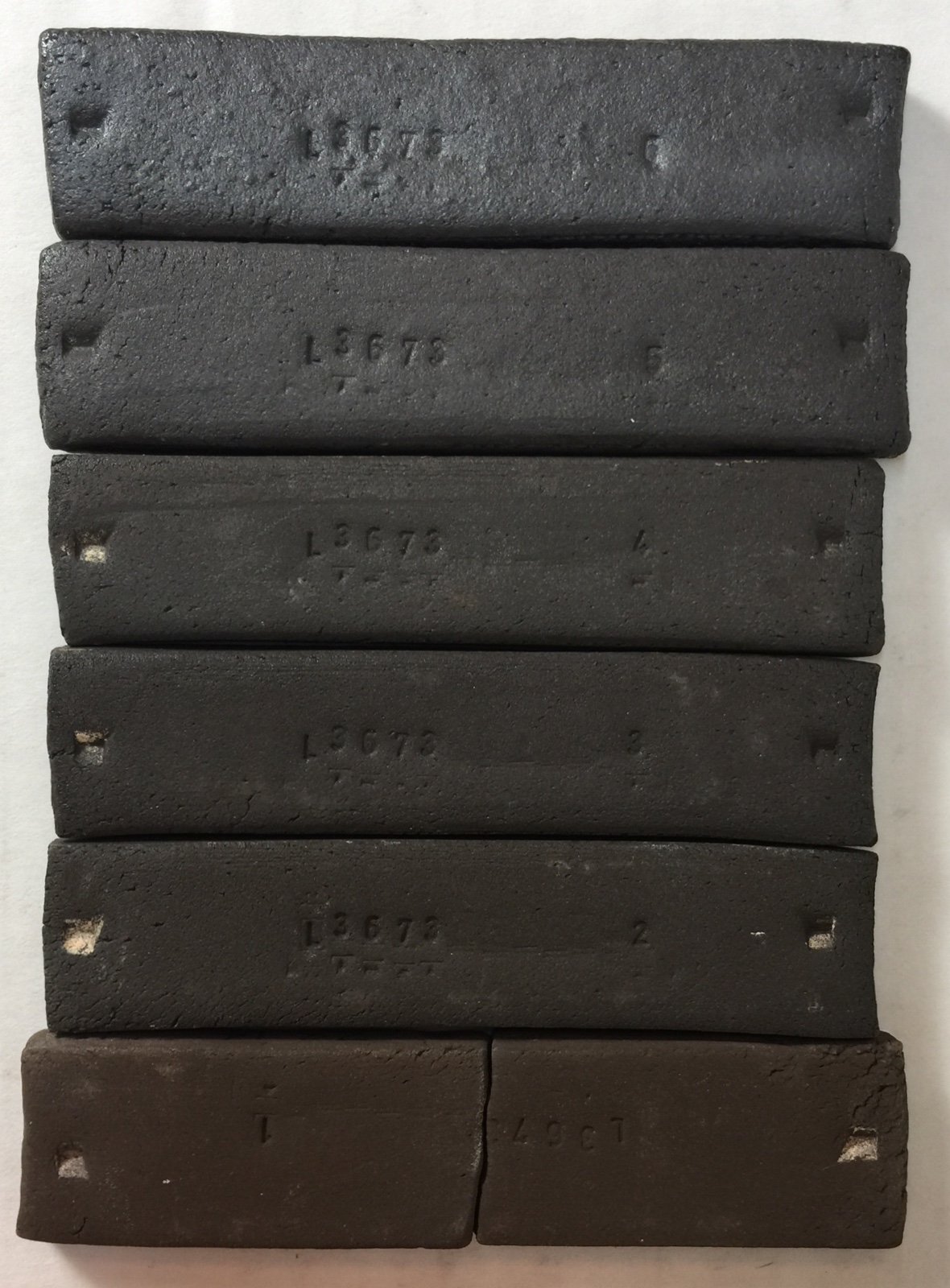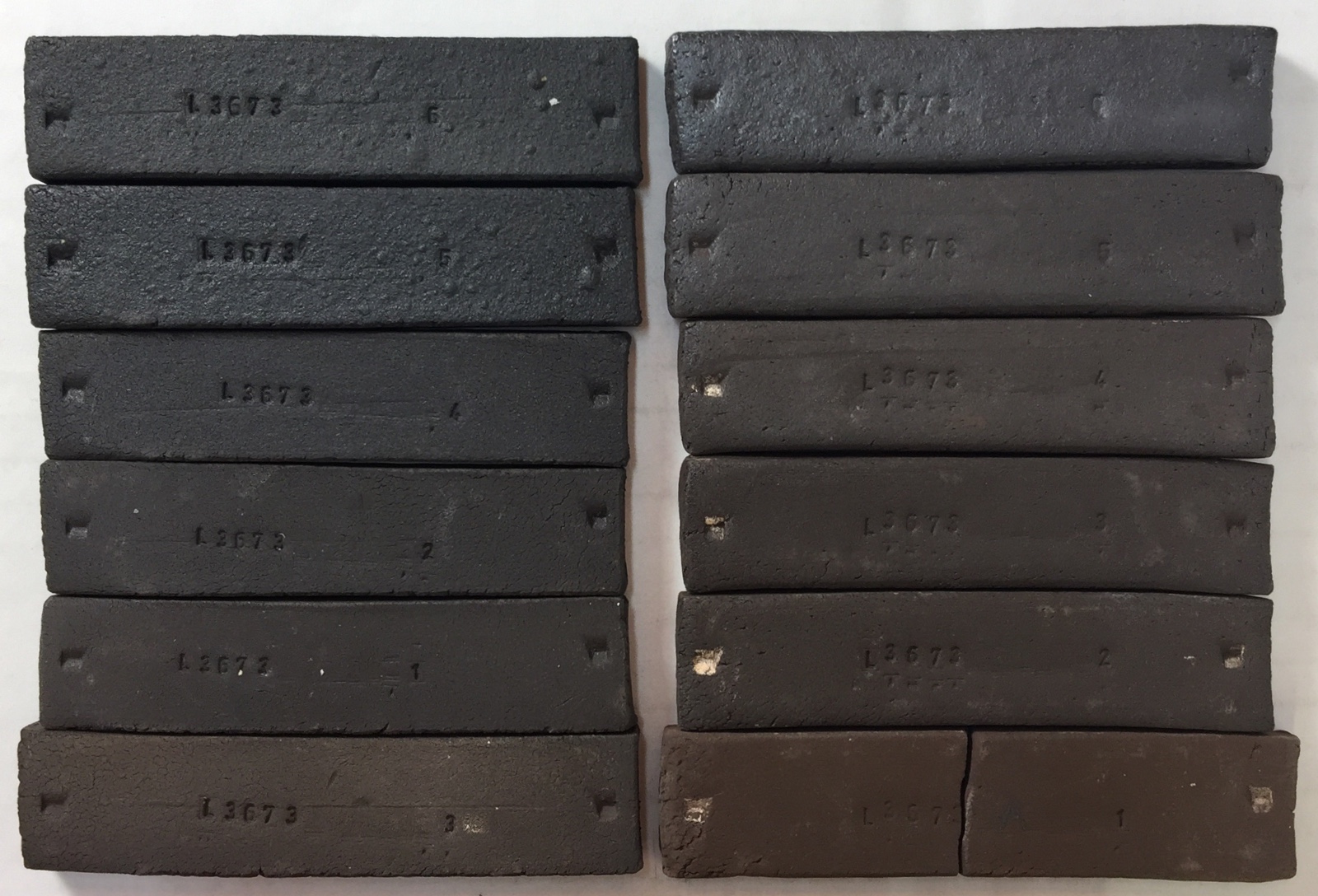Barnard Slip
|
Code # L2626 |
Location BD 822 |
| Materials | Amt |
|---|---|
| Barnard Slip | 100.000 |
Total:100.00
|
Si:Al: 10.0:1 6.1 (Molar:5.0) 8.3 |
Notes
Fired bars are very dark brown at cone 02 proceeding to black by cone 4. At cone 6 it is beginning to melt, indicating that the chemistry information here is not accurate, much higher fluxing oxide levels would be needed to create a material that melts at this low a temperature.
The clay is very non-plastic silty and very difficult to form test bars with. The high water content of the material, given its low plasticity, indicates a very small ultimate particle size.
This has the potential to be a base for a black burning casting slip body at cone 6 (with the addition of enough ball clay to suspend the slurry and impart enough shrinkage to enable pieces to pull away from the mold). Some silica might also be needed for glaze fit.
Pictures
REDART, Barnard, Alberta Slip decorated mugs

Brushwork is under a clear glaze.
L2626 Barnard Slip bars

Testdata
SHAB - Shrinkage/Absorption
| DLEN | FLEN | FWT | BWT | CONE | DSHR | FSHR | ABS | |
| 6 | 96.22 | 81.15 | 6.1 | 3.8% | 15.7% | |||
| 4 | 95.97 | 80.87 | 39.22 | 39.6 | 4.0 | 4.0% | 15.7% | 1.0% |
| 5 | 95.89 | 81.11 | 39.46 | 39.71 | 4.0 | 4.1% | 15.4% | 0.6% |
| 3 | 95.63 | 80.14 | 38.38 | 38.89 | 3.3 | 4.4% | 16.2% | 1.3% |
| 2 | 96.02 | 80.93 | 38.91 | 39.69 | 2.0 | 4.0% | 15.7% | 2.0% |
| 1 | 96.1 | 81.61 | 37.31 | 38.26 | 1.8 | 3.9% | 15.1% | 2.5% |
| 7 | 96.13 | 81.44 | 3.9% | 15.3% | ||||
| 8 | 96.59 | 85.48 | 40.45 | 44.65 | -4.0 | 3.4% | 11.5% | 10.4% |
LDW - LOI/Density/Water Content
| WWGT | DWGT | FWGT | H2O | LOI | DENS | |
| 1 | 31.52 | 23.86 | 22.11 | 24.3% | 7.3% |
XML (to paste into Insight)
<?xml version="1.0"?> <recipes version="1.0" encoding="UTF-8"> <recipe name="Barnard Slip" id="69028" key="szpkR7Zt" date="2025-01-22" codenum="L2626" location="BD 822" picturebasename=""> <recipelines> <recipeline material="Barnard Slip" amount="100.000"/> </recipelines> </recipe> </recipes>
Born: 1995-05-23, Modified: 2025-01-22 22:04:37
Laguna Barnard Slip Sub
|
Code # L3673 |
Location BOX52 |
Notes
This reaches maxiumum vitrification around cone 4, similar to real Barnard Slip.
This is a much more plastic material (almost 7% drying shrinkage vs. 4%). This will make it behave much differently when use pure or in a high percentage in a slip or engobe.
It does not have the deep fired color of real Barnard.
Pictures
Testdata
SHAB - Shrinkage/Absorption
| DLEN | FLEN | FWT | BWT | CONE | DSHR | FSHR | ABS | |
| 6 | 93.12 | 83.68 | 33.8 | 36.16 | 6.0 | 6.9% | 10.1% | 7.0% |
| 5 | 93.33 | 85.09 | 34.06 | 36.6 | 5.0 | 6.7% | 8.8% | 7.5% |
| 4 | 93.3 | 82.07 | 34.47 | 34.67 | 4.0 | 6.7% | 12.0% | 0.6% |
| 3 | 94.18 | 81.88 | 34.18 | 34.6 | 3.0 | 5.8% | 13.1% | 1.2% |
| 2 | 93.18 | 82.8 | 34.14 | 35.22 | 2.0 | 6.8% | 11.1% | 3.2% |
| 1 | 93.01 | 87.7 | 33.68 | 38.14 | -4.0 | 7.0% | 5.7% | 13.2% |
| 7 | 92.99 | 92.29 | 35.87 | 43.72 | -6.7 | 7.0% | 0.8% | 21.9% |
LDW - LOI/Density/Water Content
| WWGT | DWGT | FWGT | H2O | LOI | DENS | |
| 1 | 23.11 | 17.66 | 16.29 | 23.6% | 7.8% |
XML (to paste into Insight)
Born: 2013-04-12, Modified: 2018-08-12 20:46:58
Barnard Chemical Substitute
|
Code # L4068 |
| Materials | Amt |
|---|---|
| Redart | 70.000 |
| Silica | 14.000 |
| Manganese Dioxide | 4.500 |
| Red Iron Oxide | 11.500 |
Total:100.00
|
Si:Al: 9.3:1 6.5 (Molar:5.3) 3.9 Cost 0.44 per kg |
Notes
Redart makes a good base because it has low plasticity and already contains some iron. All it needs is some silica to match the percentage analysis of Barnard fairly closely.
I am doing a Mole% calculation because the LOI of these two differs and that makes it hard to compare percentage analyses.
This recipe produces a higher proportion of total fluxes than Barnard Slip, but since this is a compound it will not likely melt as well, even with the same chemistry (so the extra fluxes will help). The calculated thermal expansion is also higher, but still relatively low compared to most glazes.
This has a lower LOI, that may be helpful with some underglaze situations.
This has a low Si:Al ratio, but not different enough to be an issue.
Pictures
XML (to paste into Insight)
<?xml version="1.0"?> <recipes version="1.0" encoding="UTF-8"> <recipe name="Barnard Chemical Substitute" id="138015" key="vMunhTAq" date="2018-08-15" codenum="L4068"> <recipelines> <recipeline material="Redart" amount="70.000" tolerance=""/> <recipeline material="Silica" amount="14.000" tolerance=""/> <recipeline material="Manganese Dioxide" amount="4.500" tolerance=""/> <recipeline material="Red Iron Oxide" amount="11.500" tolerance=""/> </recipelines> </recipe> </recipes>
Born: 2018-08-12, Modified: 2018-08-15 22:59:10


